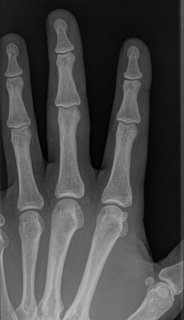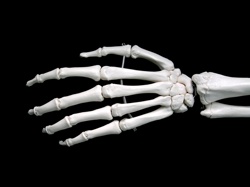
On Monday we got to the end of the upper limb and looked at the forearm, wrist and hand. We will be going back up to the shoulder and the brachial plexus in particular after Christmas.
In my station we looked at the bones of the wrist and hand. Easy enough, and stuff the medical student must know. The hand is incredibly important to everyday life, and injuries occur from sharp instruments (but hopefully not in dissection labs) and falls. The bones are subject to injuries from falls and crushing.
You can review the bones of the hand in this elearning thing I made with the help of some very talented students from the Swansea Metropolitan University here: bones of the hand.
 Looking at the carpal bones you can see 2 rows of 4 bones each. The proximal row has the scaphoid bone on the thumb side, which is commonly fractured by using the hands to break a fall. We worked across the lunate, triquetral and pisiform bones to the little finger side of the wrist. Beware that the pea-like pisiform bone appears to be fused with the triquetral bone on all the plastic models, so take a look at the real bones in the lab and notice how these bones are separate and how beautifully they fit together.
Looking at the carpal bones you can see 2 rows of 4 bones each. The proximal row has the scaphoid bone on the thumb side, which is commonly fractured by using the hands to break a fall. We worked across the lunate, triquetral and pisiform bones to the little finger side of the wrist. Beware that the pea-like pisiform bone appears to be fused with the triquetral bone on all the plastic models, so take a look at the real bones in the lab and notice how these bones are separate and how beautifully they fit together.
The first bone of the distal row on the little finger side is the hamate. This bone stands out and should be easily recognised by its hook on the palmar side of the hand. All these protuberances and tuberosities (like the hook of the hamate) are helping form the carpal tunnel, through which the flexor tendons (and median nerve) pass to reach the fingers. Muscles tend to attach to tuberosities, so bear this in mind when looking at the bones and at the intrinsic muscles of the hypothenar eminence and the thenar eminence. The plastic bone models coloured in blue and red are good for this.
Moving back towards the thumb we find the capitate, trapezoid and trapezium bones. I failed to mention that you can remember the location of the trapezium bone by remembering that the trapezium is at the base of the thumb. Notice also the shape of the trapezoid bone on a model of the carpal bones. It has a distinctive wide, flat base dorsally and a narrower flat top ventrally.
The carpal bones can slide over one another to give the movements of the wrist that we are familiar with. The metacarpal bones for digits 2 to 5 are tied together by connective tissues, but the metacarpal bone of the thumb is free, allowing a greater range of movement, including opposition. The articular joint between the trapezium and the metacarpal bone of the thumb allows rotation as well as flexion, extension, abduction and adduction. Remind yourself of the movements of the thumb, and that the thumb lies on a plane at right angles to the plane of the fingers (look at the directions that your nails face to emphasis this).
Each digit has 3 phalanges (proximal, middle and distal) except for the thumb that has only two. The metacarpophalangeal joints are shaped to allow flexion, extension, abduction and adduction of the fingers. The interphalangeal joints allow only flexion and extension, as hinge joints.
Very simple, very clear anatomy, but the type of anatomy that is almost guaranteed to turn up in exams from time to time. These should be very easy marks.
Links:
The movements of the hand (by me!)
Comments
8 responses to “Week 112: bones of the hand and wrist”
Is it possible to use a copy of the photo of the hand bones with the following citation below the photo:
http://www.dontbeasalmon.net/images/photos/hand%20and%20wrist%20bones.jpg
in a Powerpoint presentation?
Hi Marcia. Yes, feel free to use that image. Thanks for asking.
Is it OK to use this photo in my report as well?
http://www.dontbeasalmon.net/images/photos/hand%20and%20wrist%20bones.jpg
Yes, please do.
Hi sam ,
is it okay if i use the image on a video im making, it may go on youtube.
Sorry, Dalia, I missed this. But yes, please do.
I found what I suspect to be a few human finger bones. From best I can tell, it appears to be the two bones that make up the thumb. What would be the end bone is slightly pointy, not rounded with what appears to be a ball on the tip of the other fingers, and some images of the thumb skeleton I have found. Who.can tell me if I have a human thumb?
Try your local university if they have a medical school.